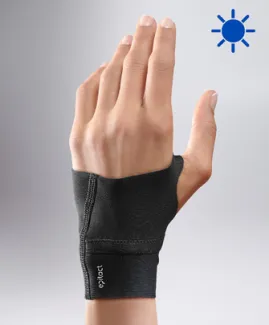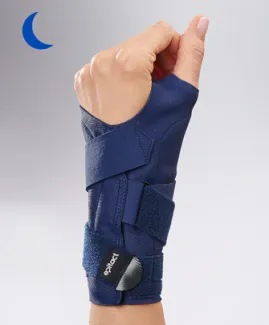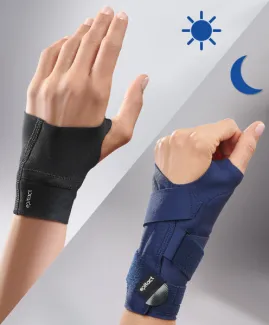
Diagnosis of carpal tunnel syndrome (CTS) is made by a health professional. He prescribes you different examinations according to your signs and symptoms. After asking you some questions, he can perform some tests (Tinel’s, Durkan’s or Phalen’s test for carpal tunnel syndrome) and imaging examinations.
The steps in the diagnosis determine what is the best treatment for you according to the intensity of your symptoms. Learn more about them with EPITACT®!
Diagnosis of carpal tunnel syndrome: what to do before your consultation?
Before doing any tests for carpal tunnel syndrome, your doctor asks you some questions about your symptoms, your family and medical history. In order to prepare your consultation as well as possible, identify your symptoms and their intensity.
Do you have tingling, numbness, pain or loss of sensitivity? Which part of your hand is affected? Are these sensations mild, moderate or severe? Do they occur at night, during the day or both? How long do your symptoms last: a few minutes, hours, continuously?
Or maybe do you sometimes drop an object? Do you feel a loss of grip strength or less precision (difficulty holding a pen, a phone, carrying weight or opening a bottle, etc.)?
By assessing your symptoms and the type of movements that are impossible or just difficult to do, your doctor can establish the diagnosis of carpal tunnel syndrome and eliminate hypotheses of other conditions.
Tests for carpal tunnel syndrome: Tinel’s test, Phalen’s test and Durkan’s test
Physical examination enables your doctor to assess sensitivity in your fingers and to test muscle strength in your hands. He also evaluates your discomfort during specific movements such as wrist flexions. You’ll probably be asked to do some provocation tests of carpal tunnel syndrome in order to identify painful postures and analyse the severity of the disease. Discover now the Durkan’s test, the Tinel’s test and the Phalen’s test for carpal tunnel syndrome.
Carpal tunnel syndrome: Tinel’s test
The Tinel’s test is used for assessing neurological functioning. It consists in slightly hitting the median nerve in the carpal tunnel. If it causes electric shocks, paraesthesia (tingling) or pain, the test is positive, i.e you can be suffering from carpal tunnel syndrome.
Phalen’s test for carpal tunnel syndrome
This test was invented by George Phalen in 1966 but since then, it has progressed. Its goal is to reproduce the symptoms felt by the patients in the fingers. The more severe the syndrome, the more reliable the tes.
Hold your hands together, back to back with fingers pointing down. This position forces you to flex the wrist at 90°. Keep this position for one minute: it increases the pressure on the median nerve. If you feel a loss of sensitivity, it can be linked with carpal tunnel syndrome.
The reverse Phalen’s test for carpal tunnel syndrome is another manoeuvre that consists in holding the hands together, palm to palm with the fingers extended and the wrists at 90°. Keep this position for one minute. This time, the nerve is not compressed but stretched. Here again, if you have a tingling sensation, it may be CTS.
Durkan’s test
In case of carpal tunnel syndrome, the Durkan’s test also aims to reproduce the symptoms of the disease. Use your thumb to slightly apply pressure on the median nerve in the carpal tunnel during 30 seconds. It is sufficient to compress the median nerve and to observe the effects.
The physical examination and the Durkan, Phalen and Tinel’s tests for carpal tunnel syndrome can be sufficient for the health professional to propose an appropriate treatment. However, complementary examinations are often necessary to confirm and precise the diagnosis. Indeed, certain diseases include symptoms that are close to those of CTS, such as tendinitis or rheumatism.
Medical imaging to diagnose CTS
Hand or wrist X-ray can identify a bone-related cause to carpal tunnel syndrome. This can be associated with sequelae of an old fracture or in case of wrist osteoarthritis. These two examples can cause narrowing of the carpal tunnel and compress the median nerve.
Ultrasound can also identify other causes that could be responsible for narrowing of the tunnel, and consequently CTS.
Carpal tunnel syndrome: diagnosis with electromyogram (EMG)
Sometimes, clinical signs are misleading or insufficient to establish the diagnosis of carpal tunnel syndrome. In this case, electromyogram can be necessary to measure electrical activity of the median nerve. Electrodes, placed along the nerve, record the transmission of electrical waves to reveal potential lesions. Slackening of electrical impulses in the carpal tunnel confirms CTS.
Both hands are examined because the condition can affect them at the same time.
EMG defines the severity of the condition and can exclude some causes of similar symptoms like compression in the neck.
All these examinations and tests for carpal tunnel syndrome contribute to reliable diagnosis and appropriate treatment. Your doctor can prescribe you a rigid brace for resting periods* or a flexible brace for activities*. Surgical intervention is also possible according to the degree of the condition.

*These solutions are medical devices that bear the CE marking under this regulation. Carefully read the instructions before use. Manufacturer: MILLET Innovation. 09/2021
 Pharmacie
Pharmacie

